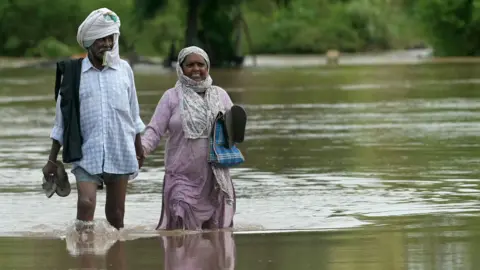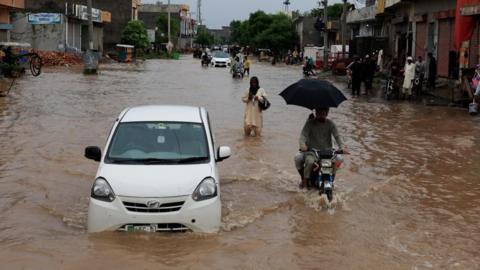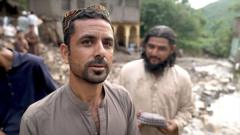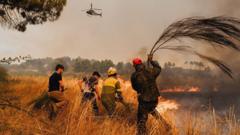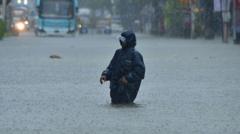Amid the backdrop of a flooded church, Jamaica Aguilar and Jade Rick Verdillo exchanged vows, defying the chaos brought on by monsoon rains and a typhoon. Their wedding at Barasoain Church, a venue steeped in history, became a viral sensation on social media, showcasing not only their determination but the evolving narrative of Filipino resilience.
Yet, this was not an isolated incident; it echoed a story that began two years earlier when another couple exchanged their vows amid similar conditions at the same church. Flooded weddings have become emblematic of larger issues plaguing the Philippines—issues rooted in inadequate infrastructure, poor urban planning, and increasingly severe weather patterns.
The challenges of holding a wedding in a flooded church were significant. The bride, contemplating canceling the ceremony just the night before due to worsening forecasts, decided to move forward with the celebration despite the water lapping around her ankles. "It was more about our relationship and the people who came to support us," the groom shared, highlighting the couple's focus on love over adversity.
Post-wedding, the couple had to take doxycycline, a preventive antibiotic against potential flood-related illnesses like leptospirosis—a stark reminder of the perils associated with their wedding day. Just hours later, the same flooding that capped their joyous moment would serve as a backdrop for a funeral, illustrating the grave realities faced by so many.
Typhoon Wipha (Crising) was merely the latest in a series of storms ravaging the Philippines, a nation notoriously vulnerable to tropical cyclones. Already, six lives had been lost and thousands displaced since the storm's arrival, with forecasts warning of more storms to come. This precarious situation cast a shadow over President Ferdinand Marcos Jr.'s upcoming State of the Nation Address, drawing criticism over the allocation of resources towards political rather than humanitarian efforts.
In the heart of the nation, Metro Manila's flooding crisis persists, compounded by a historically poor waste management system and outdated drainage infrastructure. Public works minister Manuel Bonoan emphasized the critical state of these systems, revealing that much of Metro Manila's sewage network dates back to the early 1900s and is plagued by chronic clogging.
Experts point to urban designs that obstruct natural waterways, exacerbating the problem. The government is exploring potential solutions, with initiatives coordinated with international partners aimed at addressing the flooding, but tangible improvements are still years away.
For Verdillo and Aguilar, even as they navigated floodwaters to reach the altar, hope persists that forthcoming infrastructural enhancements could one day free future couples from this quandary. "There’s so much water here in the Philippines; the government needs to invest in better flood management," Verdillo remarked, summing up the intertwined narratives of love and struggle that each flooded aisle now represents in the nation.
Yet, this was not an isolated incident; it echoed a story that began two years earlier when another couple exchanged their vows amid similar conditions at the same church. Flooded weddings have become emblematic of larger issues plaguing the Philippines—issues rooted in inadequate infrastructure, poor urban planning, and increasingly severe weather patterns.
The challenges of holding a wedding in a flooded church were significant. The bride, contemplating canceling the ceremony just the night before due to worsening forecasts, decided to move forward with the celebration despite the water lapping around her ankles. "It was more about our relationship and the people who came to support us," the groom shared, highlighting the couple's focus on love over adversity.
Post-wedding, the couple had to take doxycycline, a preventive antibiotic against potential flood-related illnesses like leptospirosis—a stark reminder of the perils associated with their wedding day. Just hours later, the same flooding that capped their joyous moment would serve as a backdrop for a funeral, illustrating the grave realities faced by so many.
Typhoon Wipha (Crising) was merely the latest in a series of storms ravaging the Philippines, a nation notoriously vulnerable to tropical cyclones. Already, six lives had been lost and thousands displaced since the storm's arrival, with forecasts warning of more storms to come. This precarious situation cast a shadow over President Ferdinand Marcos Jr.'s upcoming State of the Nation Address, drawing criticism over the allocation of resources towards political rather than humanitarian efforts.
In the heart of the nation, Metro Manila's flooding crisis persists, compounded by a historically poor waste management system and outdated drainage infrastructure. Public works minister Manuel Bonoan emphasized the critical state of these systems, revealing that much of Metro Manila's sewage network dates back to the early 1900s and is plagued by chronic clogging.
Experts point to urban designs that obstruct natural waterways, exacerbating the problem. The government is exploring potential solutions, with initiatives coordinated with international partners aimed at addressing the flooding, but tangible improvements are still years away.
For Verdillo and Aguilar, even as they navigated floodwaters to reach the altar, hope persists that forthcoming infrastructural enhancements could one day free future couples from this quandary. "There’s so much water here in the Philippines; the government needs to invest in better flood management," Verdillo remarked, summing up the intertwined narratives of love and struggle that each flooded aisle now represents in the nation.





